
The Runes
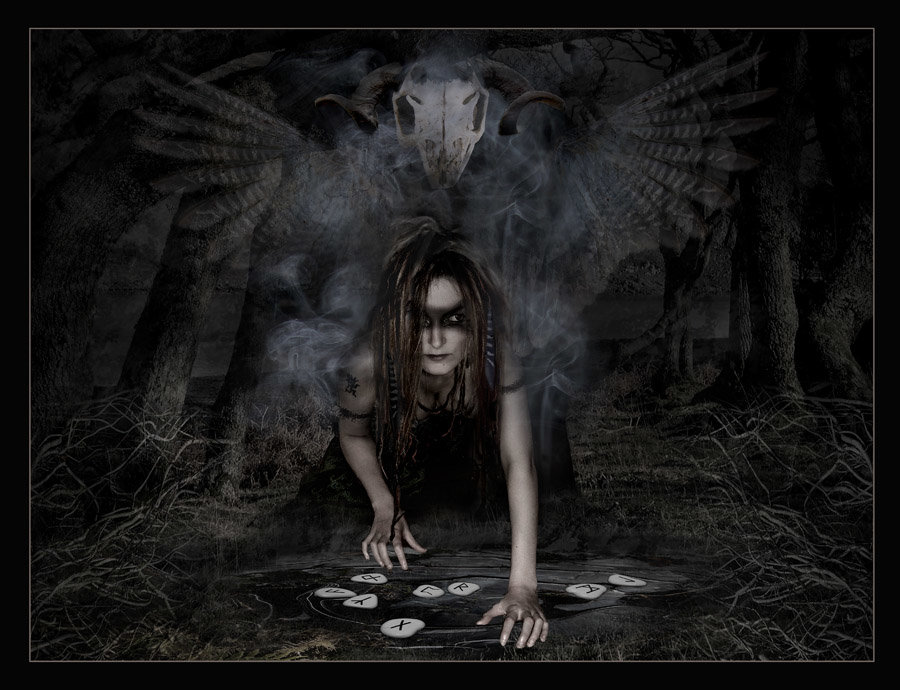
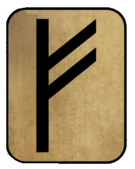 FEHU (Feoh/Fe/Fa): cattle Phonetic equivalent: F
FEHU (Feoh/Fe/Fa): cattle Phonetic equivalent: F
DIVINATORY MEANINGS:
Prosperity, money, wealth, concern with physical and financial needs, goals, promotion, self-esteem, centeredness, karma
MAGICAL USES:
For money, business, promotion, finding a job, achieving a goal, starting new enterprises
ASSOCIATED MYTHS & DEITIES:
Freyr, Brisingamen, Gullveig, Dwarfs, Sigurd & the Otter's Gold
ANALYSIS:
Fehu is both the day-to-day reality of our lives and the catalyst that awakens us to what lies beyond. It is whatever we think we are seeking, which frequently bears no resemblance to what we will eventually find. It is also our home, for after all our wanderings we will still need to attend to our physical needs and ground ourselves in the simple pleasures of home, family, and good work. Oz might be a fun place to visit, but after a while all you really want to do is go back to Kansas.
Fehu reminds us that we must be secure in our physical situation before embarking upon any spiritual journey. We all must begin with the mundane reality of our lives, although many people never get beyond this. In many ways, we have become as domesticated as the cattle, living our day to day existence without wanting or even being aware of anything more being possible. The first step in breaking away from this situation is to catch a glimpse of what is possible, without dwelling on what security we may lose to attain it.
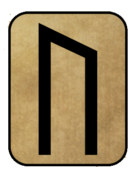 URUZ (Ur): aurochs Phonetic equivalent: U
URUZ (Ur): aurochs Phonetic equivalent: U
DIVINATORY MEANINGS:
Energy, passion, vitality, instinct, wildness, sexuality, fertility, the unconscious, primitive mind, irrationality, shamanic experience, rite of passage
MAGICAL USES:
To strengthen the will, increase sexual potency and energy; for hunting
ASSOCIATED MYTHS & DEITIES:
Ullr, Loki, Odin (as shaman)
ANALYSIS:
The aurochs was a species of wild ox, similar to a longhorn bull, that was once found all over Europe, but which became extinct sometime in the 17th Century. They were said to be
slightly smaller than elephants, and had horns as long as six feet, which were highly prized by the Germanic as drinking horns. This may or may not have been an exaggeration. Paintings of aurochs have been found in Neolithic caves, and it is believed that the aurochs hunt had some significance as a rite of passage for a boy entering manhood. The aurochs is the epitome of the wild animal, as opposed to the domesticated cattle represented by fehu.
Uruz is the rune of the God of the sacred hunt and his shaman/priest. Following the kind of mundane, day to day survival represented by fehu, it is the first recognition by mankind of the divine in nature, and his first attempt to control it through the use of sympathetic magic. It also represents an awareness of death and our own mortality, which may well be the only thing which truly distinguishes us from other animals. The energy of this rune is raw, powerful, and distinctly masculine, in the sense that it is pure, elemental fire. The boy who has killed the aurochs has just entered manhood, and has therefore been initiated into the first level of the mysteries - the awareness that the source of life is death.
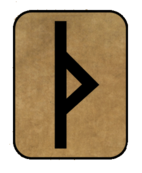 THURISAZ (Thorn): giant Phonetic equivalent: TH (as in 'thing')
THURISAZ (Thorn): giant Phonetic equivalent: TH (as in 'thing')
DIVINATORY MEANINGS:
Hardship, painful event, discipline, knowledge, introspection, focus
MAGICAL USES:
Aid in study and meditation, self-discipline, clearing out a bad situation
ASSOCIATED MYTHS & DEITIES:
The Frost Giants, Loki
ANALYSIS:
Thurisaz is the first of the 'obstacle' runes. These obstacles are not necessarily destructive things, but are placed in our path to strengthen and teach us. After all, you can't have a mythic hero without dragons to slay or giants to fight!
The lesson of this rune is 'to learn you must suffer', meaning not only literal suffering, but also in the biblical sense of 'allowing' - allowing one's destiny to unfold as it should, and allowing one's self to experience all that life offers us. What may at first appear to be a negative, destructive event, may well turn out to contain an important lesson. The Giants may seem to be evil and destructive to the Aesir, but they bring about change, and eventually clear the way for a new age.
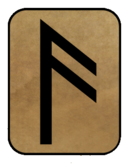 ANSUZ (As/Ansur/Os) : Odin Phonetic equivalent: A (as in 'fall')
ANSUZ (As/Ansur/Os) : Odin Phonetic equivalent: A (as in 'fall')
DIVINATORY MEANINGS:
Authority figure, leader, mind & body balance, justice, shaman, clairvoyant
MAGICAL USES:
For wise decisions, success, leadership; to help in divination and magic
ASSOCIATED MYTHS & DEITIES:
Odin
ANALYSIS:
This rune represents the instinctive, primal energy of uruz tempered with the discipline and experience of thurisaz. These elements are combined in the personage of Odin, who exhibits the characteristics of both chieftain and shaman - a god of wisdom as well as war. Odin is also a shaman, travelling between the worlds on his eight-legged horse, Sleipnir.
Ansuz is a balanced rune. As with fehu, many people choose to remain at this point in their journey. It represents power, both secular and magical, and this power can be quite seductive. Odin has learned the lessons of the first three runes, thus gaining the wisdom to rule wisely, but this is really only another beginning. He has only gained temporal power, and has only a few of the tools he will need to perfect himself spiritually. There is a certain lack of compassion and perspective in this rune. Odin sits high above his world, looking down and making decisions, but he doesn't yet have the capacity to really care about or understand his people or himself. He still needs that emotional connection to become a truly great leader
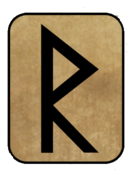 RAIDO (Rad/Reidh/Raidho): journey Phonetic equivalent: R
RAIDO (Rad/Reidh/Raidho): journey Phonetic equivalent: R
DIVINATORY MEANINGS:
Journey, pilgrimage, change, destiny, quest, progress, life lessons
MAGICAL USES:
Protection for travelers, to ease or bring about change, to reconnect
ASSOCIATED MYTHS & DEITIES:
The Norns, Sigurd's journey
ANALYSIS:
Raido represents the path of a person's life and how it intersects and interacts with other paths. In Norse mythology, these paths are seen as threads of fate, and are regulated by the Norns. The Norns are three sisters who live near the first root of Yggdrasil, which they tend with the water from the well of Wyrd. They also spin the fates of Gods and men, which is important when understanding the mechanism of runic divination and magic.
The complex network of relationships formed by these threads of fate can be thought of as a web. Every chance encounter forms another connection in the web, and by tugging on one thread you affect everything else in the system. Most people do this completely unconsciously, but by becoming aware of the pattern of the threads surrounding you, it becomes possible to recognize and follow up on the kind of catalytic events that seemed to happen to us randomly back at fehu. In this way, we can find our way more easily along the path of our own journey, thus deriving the greatest benefit from its lessons. Otherwise we tend to get distracted and end up on detours and dead ends.
Raido reminds us that, although it may seem that we have accomplished our goals at ansuz, life and change continue and we must always go on. We will eventually end up where we began, but on a higher level and with a better perspective. The journey never really ends.
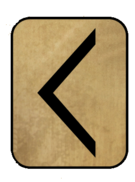 KENAZ (Ken/Kano): torch Phonetic equivalent: C (as in 'candle')
KENAZ (Ken/Kano): torch Phonetic equivalent: C (as in 'candle')
Wisdom, insight, solution to a problem, creativity, inspiration, enlightenment
MAGICAL USES:
For creative inspiration, aid in study, fertility, dispelling anxiety and fear
ASSOCIATED MYTHS & DEITIES:
Mimir, the Dwarfs, Muspellheim
ANALYSIS:
In modern usage, the Scottish 'ken' means to know or understand, and this is the sense in which the rune should interpreted. Today, light, inspiration and knowledge are often associated, as in 'gaining enlightenment' and 'shedding light on the problem', and even in the image of a light bulb going on over someone's head when they get an idea. To bring light is to make the invisible visible.
Unlike the wisdom gained at thurisaz, kenaz only allows us to take bits and pieces of this knowledge away with us as we need it, usually at the discretion of the Gods. This knowledge will generally come in the form of a sudden inspiration, and we will be able to see clearly the answer that was once hidden from us. This form of wisdom is more closely associated with the right half of the brain than the left, since it does not come through conscious effort but rather through passively opening one's self to it. Thus, a more feminine element is added to our journeyer's experience.
The act of bringing light into the darkness is also a creative one. Again consider the image of the person carrying a torch, representing the masculine elements of fire and air, entering the cave and penetrating the feminine realm of earth and water. This joining of masculine and feminine elements results in the creation of new ideas. In physical terms, this can be correlated to the application of fire to mold and shape matter - the art of the smith.
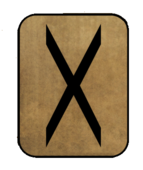 GEBO (Gyfu): gift Phonetic equivalent: G (as in 'girl')
GEBO (Gyfu): gift Phonetic equivalent: G (as in 'girl')
DIVINATORY MEANINGS:
Gift, offering, relationship, love, marriage, partnership, generosity, unexpected good fortune
MAGICAL USES:
To find or strengthen a relationship, for fertility, to mark a gift or offering, to bring luck
ASSOCIATED MYTHS & DEITIES:
Sigurd & Brunhild: Aesir & Vanir treaty
ANALYSIS:
Gebo is a rune of connection, particularly the connections between people. Up until now, our journey has been a solitary one. This rune represents those places where our path intersects with others, and allows us to begin to form conscious relationships. Such relationships are strengthened and sanctified by the exchange of gifts.
The use of the gift as a symbol of an oath or a bond is an ancient one. When a lord wanted to ensure the loyalty of one of his subjects, he would give that person a gift. The gift would create a debt on the part of the person receiving it, and this debt would ensure his readiness to serve his lord. Similarly, a gift given between lovers, especially that of the ring, symbolizes the bond between them. Originally, only the man gave the ring in a marriage for much the same reason as the lord giving gifts to his vassals, but today the arrangement is usually more equitable. Gifts or offerings given to the Gods often carry the same meaning, representing the giver's love for or loyalty to their Gods. The giving of a gift implies the acceptance of a debt with the understanding that the debt will not be repaid
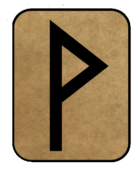 WUNJO (Wyn/Wynn) : glory Phonetic equivalent: W
WUNJO (Wyn/Wynn) : glory Phonetic equivalent: W
DIVINATORY MEANINGS:
Success, recognition of achievements, reward, joy, bliss, achievement of goals, contentment
MAGICAL USES:
For success in any endeavor, to motivate, to complete a task.
ASSOCIATED MYTHS & DEITIES:
Baldr, Asgard
ANALYSIS:
Wunjo is the last rune of the first aett, and thus represents both the end of one cycle and preparation for the next. It is a very positive, stable rune, and is another place where people tend to get stalled along their journey. Christian poets related it to heaven, but in fact it more closely resembles the Pagan Valhalla, since this particular paradise is not a permanent one.
Like the wealth of fehu, the glory of wunjo is only an illusion. We have achieved success on one level only, and there are many more lessons to be learned. It is, however, a welcome respite which allows us to rest, re-charge our batteries and prepare ourselves for the rest of the journey. It also gives us some perspective, allowing us to look back and reflect on the road thus far. Wunjo gives us a glimpse of what is possible, but if we try too soon to reach out and grab it, like the Grail it will disappear between our fingers.
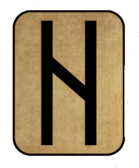 HAGALAZ (Haga/Haegl/Hagall : hail Phonetic equivalent: H
HAGALAZ (Haga/Haegl/Hagall : hail Phonetic equivalent: H
DIVINATORY MEANINGS:
Sudden loss, ordeal, destruction, disaster, clearance, testing, karmic lesson, drastic change.
MAGICAL USES:
Removing unwanted influences, breaking destructive patterns
ASSOCIATED MYTHS & DEITIES:
Ragnarok, Loki, Frost Giants
ANALYSIS:
The idea of the destruction of the old being necessary to the growth of the new, as contained in the Norse myth of Ragnarok, is essential to our understanding of this rune. Interestingly enough, hagalaz lies between kenaz (fire) and isa (ice), reminding us of the Norse creation myth and the creative potential that lies between these two opposites, even though their meeting may seem at first to be destructive. Like the Tower in the Tarot, hagalaz is only a negative rune if we choose to view it in that way, and refuse to learn its lessons. Appearing as it does at the beginning of the second aett, it marks both a beginning and an end, and knocks us out of the safety and complacency of wunjo. It represents what a friend of mine used to refer to as the 'flying ladle syndrome' - that whenever things appear to be going too well, you can expect a good, healthy whack in the head from the Fates, just to make sure you're paying attention.
These sorts of 'wake-up calls' from the Gods will happen frequently throughout a person's life, but are often misinterpreted as divine punishment for some imagined wrong when in fact they are merely a way of drawing your attention to a recurrent pattern in your life. Unfortunately, these types of events have a tendency to repeat themselves with greater and greater severity until the lesson is learned and the pattern is broken. For example, someone who needs to break their dependency on a certain type of person will find themselves in relationships with such people over and over again with more and more disastrous results until they recognize the pattern as emanating from them and break it willingly.
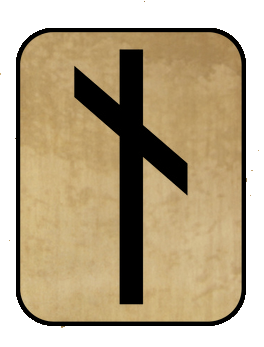 NAUTHIZ (Nyd/Naudhr): need, necessity Phonetic equivalent: N
NAUTHIZ (Nyd/Naudhr): need, necessity Phonetic equivalent: N
Poverty, hardship, responsibility, discontent, obstacle, frustration
MAGICAL USES:
To represent a need to be filled
ASSOCIATED MYTHS & DEITIES:
Freyr & Gurd, the Otter's Gold
ANALYSIS:
If hagalaz is a flying ladle, then nauthiz is the empty pot. It is a gentle, nudging reminder that all is not as it should be. Life appears to be out of synch, and nothing seems to be going right. No matter how much you have, it is never enough, and there is an ever present desire for something more, something better. On the positive side, this dissatisfaction with the status quo can serve to draw one away from the relative safety of wunjo and motivate towards change.
Nauthiz represents an imbalance between one's desires and one's assets. How you resolve this situation will influence the rest of the journey, but the awareness of the imbalance itself can also be illuminating. It causes you to closely examine and perhaps reassess your values and priorities, and forces you back onto the path of your own happiness. Perhaps mythologist Joseph Campbell said it best when he enjoined us to 'follow our bliss'; in other words, that we will know that we are on the right track spiritually when we are doing those things which make us the most happy and fulfilled. Nauthiz helps us to take the first step on that path by letting us know when we have strayed from it.
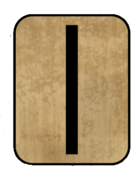 ISA (Is/Iss): ice Phonetic equivalent: I (ee as in see)
ISA (Is/Iss): ice Phonetic equivalent: I (ee as in see)
DIVINATORY MEANINGS:
Inactivity, blockage, stagnation, potential, patience, reflection, withdrawal, rest
MAGICAL USES:
To stop a process; to represent primal form
ASSOCIATED MYTHS & DEITIES:
Auðumla, Nifelheim
ANALYSIS:
In modern symbolism, fire is generally masculine and ice (or earth) is feminine, but it is unknown whether the Norse shared this association. Certainly, ice was a constant factor in their day to day lives. It threatened their crops and their ships almost throughout the year, but it also served as a symbol of creation, from which all life will eventually spring. It says something about the Norse mind that they could recognize the need to have such a seemingly destructive joining of elements in order to create and maintain life. Fire may be warm and pleasant, but it must be balanced by the freezing of winter just as birth must be balanced by death. Even the little death of sleep has been proven to be vital for our mental and physical well-being.
Isa encompasses all of these ideas, but primarily represents a period of rest before activity, and itself forms the material from which life can be created. It is matter, inert by itself, but transformed into the stuff of stars when wedded with energy. It is the immovable form acted upon the irresistible force. In many ways, the Norse predicted Einstein with their version of the creation of the universe, recognizing that everything in their world contained both fire and ice (energy and matter), and that the relationship between the two defined the processes of life itself.
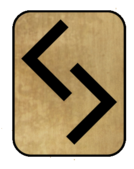 JERA (Ger) : year, harvest Phonetic equivalent: Y (but may be used in place of 'j')
JERA (Ger) : year, harvest Phonetic equivalent: Y (but may be used in place of 'j')
DIVINATORY MEANINGS:
Change, cycle turning, reward, motion, productivity, inevitable development
MAGICAL USES:
To bring change; for fertility and growth
ASSOCIATED MYTHS & DEITIES:
Sif, Thor, Freyr, Granni
ANALYSIS:
In this modern age of central heating and oranges in February, it is difficult to imagine the close ties that people once had with the cycles of the year, particularly in the more Northern climes. The changing seasons affected not only the weather, but also the day to day activities and even the diets of ancient peoples. Constant change was the norm, and the object was to become attuned with those changes, not to fight against them. An ancient farmer (or even some modern ones) wouldn't need to look at a calendar to tell him when to plant, or read a weather forecast to know when the snows were coming. The changing seasons were a part of his blood and bones, and his very existence depended on adapting to change.
Jera follows Isa just as spring follows winter. The frozen stagnancy of ice is broken by the turning of the wheel, and things are once again moving along as they should. In fact, we have now broken out of the entire set 'negative' runes with which we began this aett. This has been accomplished not by fighting to escape the ice or railing against the unfairness of fate, but by learning from those experiences and simply waiting for the inevitable thaw. Jera is the communion wine - the product of the joining of opposites bringing life. Storms may come and go, but the sun is always there and life is generally pretty good. Enjoy it while you can.
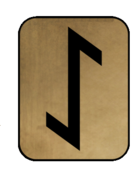 EIHWAZ (Eoh): yew Phonetic equivalent: EI
EIHWAZ (Eoh): yew Phonetic equivalent: EI
DIVINATORY MEANINGS:
Change, initiation, confrontation of fears, turning point, death, transformation
MAGICAL USES:
To bring about profound change, to ease a life transition
ASSOCIATED MYTHS & DEITIES:
Hel, Yggdrasil
ANALYSIS:
The yew tree has been associated with runes, magic and death in northern and Western Europe since time immemorial. The reasons for this ancient association are numerous, but seem to principally derive from the fact that yews are evergreens which retain their greenery even through the death of winter, and because their red berries are symbolic of the blood of life. The yew is also extremely long-lived, thus effectively 'immortal'. Reverence for the yew dates back to before the times of the Celts, and continues today in Christian tradition. Eihwaz is the thirteenth rune in the futhark, and marks the middle of the alphabet. (It is interesting to note that the Death card in the Tarot is also the thirteenth card.) This rune is the turning point in the runic journey, and represents the transformation phase of the initiatory process. All rites of passage, particularly those marking the transition into adulthood, contain the symbolism of death, the idea being that one's former 'self' has died and given birth to a new persona. Eihwaz is the passage through which we must enter the realm of Hel in order to gain the knowledge and acceptance of our own mortality, as well as those mysteries which can only be learned from the dark Lady of the dead. The process is a truly frightening one, but it is something we all must go through if we are to confront our deepest fears and emerge with the kind of wisdom that cannot be taught but must be experienced. Eihwaz is the gateway to this wisdom, and lies between life (jera) and rebirth (perthro).
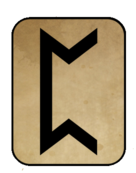 PERTH (Peorth/Perthro) : dice-cup or vulva Phonetic equivalent: P
PERTH (Peorth/Perthro) : dice-cup or vulva Phonetic equivalent: P
DIVINATORY MEANINGS:
Rebirth, mystery, magic, divination, fertility, sexuality, new beginning, prophecy
MAGICAL USES:
Fertility, easing childbirth, to aid in divination and magic, enhancing psychic abilities
ASSOCIATED MYTHS & DEITIES:
Freya, Angrbode
ANALYSIS:
The actual interpretation of perth has been the subject of much controversy among runic scholars. The problem lies in the fact that the initial P sound doesn't occur anywhere else in the old Germanic language, leading to the belief that the word was imported from another language. The Old English rune poem seems to indicate that it had to do with some sort of game, leading many to interpret it as 'chess pawn' or 'dice-cup'. The dice-cup meaning is particularly interesting as it not only fits the shape of the rune, but also hints at such an object's original use as a container for the runes themselves. An alternate interpretation of perth is derived from the Slavic 'pizda', meaning 'vulva'. This meaning (although obscure and somewhat unlikely) fits quite well into the progression of runes up until this point, symbolizing the rebirth that follows death. Viewing it as a symbol of the womb of the Goddess, it represents the same element of the mysterious and hidden as 'dice-cup', but taken literally as 'vulva', it adds a powerful, feminine, sexual counterpart to uruz that would otherwise be missing from the futhark.
However you choose to interpret the literal meaning of perth (and again, nobody really knows what that is), the basic symbolism is that of a vessel, nurturing and giving 'birth', keeping hidden and secret all those mysteries which can be uncovered only after the initiation of death. The rune is closely tied in with the idea of fate, that the road we travel, regardless of what we choose to do along the way, is pre determined from the moment of our birth. The very act of being born sets us along a course of cause and effect, action and reaction that we may choose to follow blindly, or try to divine through the runes or other means in order that we may better understand the lessons we will learn. Perth is the beginning of this process, as well as the tool for accomplishing it.
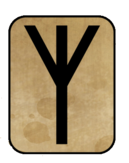 ALGIZ (Elhaz/Eolh): protection Phonetic equivalent: X,Z
ALGIZ (Elhaz/Eolh): protection Phonetic equivalent: X,Z
DIVINATORY MEANINGS:
Protection, assistance, defense, warning, support, a mentor, an ethical dilemma
MAGICAL USES:
For protection, hunting
ASSOCIATED MYTHS & DEITIES:
Heimdall Gjallerhorn
ANALYSIS:
Heimdall is an interesting and mysterious figure in Norse mythology, and I associate him with the rune algiz because of his role as protector and guardian. He is the watcher at the gate who guards the boundaries between the worlds and who charges all those entering and leaving with caution. He is best known for his famous horn, but his sword is also important in the consideration of this rune. Snorri mentions that the poetic name for a sword is 'Heimdall's head', and the poetic name for a head is 'Heimdall's sword'. This is particularly significant if we consider that one form of his name was 'Heimdali', meaning 'ram'. Through the image of the ram, Heimdall's sword and his horn can be seen as two different sides of the same image. Both the sword and the ram's horns (or the elk's antlers) are symbols of power which may be used for either offence or defense, depending on the situation.
In terms of the journey, we have passed through death and rebirth, and must now face the Guardian before returning to our world. It is he who charges us to use our new-found power wisely. The person can no longer be simply concerned with their own personal development, but must now consider the effect that their actions may have on others. This is a crucial turning point, and the person will either choose to adopt a system of ethics or ignore the effect on others and only work to serve their own ends. Again, the sword is in their hands, but they must decide whether to use it for defense or offence.
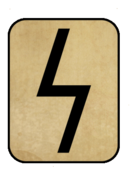 SOWELU (Sigel/Sowilo): sun Phonetic equivalent: S
SOWELU (Sigel/Sowilo): sun Phonetic equivalent: S
DIVINATORY MEANINGS:
Success, positive energy, increase, power, activity, fertility, health
MAGICAL USES:
Energy, strength, success, healing, fertility
ASSOCIATED MYTHS & DEITIES:
Sunna
ANALYSIS:
The sun is held sacred by almost every religion in the world. Its light and warmth symbolize life and growth and all that is good. Norse cosmology describes the sun being driven around the heavens in a chariot and chased by a great wolf, which will devour it at Ragnarok. Throughout Indo-European Paganism, the sun has frequently been associated with the horse, often described as being carted around the sky by a horse. Both are symbolic of life and fertility, and are usually considered 'masculine' in polarity, although in Norse myth the chariot is driven by a girl. The swastika or sun wheel is a constant motif in rock carvings dating back to Neolithic times, and occurs throughout Europe and Asia. The sun rune itself is a variation on this symbol, and represents motion and energy.
Sowulo marks the end of the second aett, and like wunjo represents success and glory. However, unlike the rest and relaxation of Valhalla, the sun is very much an active symbol. We have reached the end of the aett successfully, and the conclusion is a positive one, but in this case we are fully aware of the changing and transient nature of the universe. We can see the wolf at our heels, and we know that we must move on. Here, though, the journeyer may pause briefly in the warmth and light of the sun, absorbing and applying its energy to the work ahead. This time we won't need to be blasted out of our safe position, but will rather choose to leave it in order to continue on the journey.
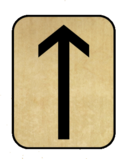 TIWAZ (Thorn) : Tyr Phonetic equivalent: T
TIWAZ (Thorn) : Tyr Phonetic equivalent: T
DIVINATORY MEANINGS:
Duty, discipline, responsibility, self-sacrifice, conflict, strength, a wound, physicality, the warrior path
MAGICAL USES:
Protection, victory, strength, strengthening the will, healing a wound
ASSOCIATED MYTHS & DEITIES:
Tyr and the Fenris Wolf, Odin's ordeals
ANALYSIS:
Just as the second aett began with the cleansing destruction of hagalaz, so too does the third aett begin with a loss. However, hail is imposed by the Gods to force the sacrifice of those things which aren't really vital to our development. Tiwaz, on the other hand, represents a voluntary sacrifice, made by someone who understands exactly what they are giving up and why.
Tyr's sacrifice of his hand to allow the binding of the Fenris Wolf was a noble one, and notable in a pantheon of deities not known for their sense of duty and ethical responsibility. He is believed to be one of the oldest of the Norse Gods - a Bronze-age rock carving was found in Scandinavia depicting a one-handed warrior - and his position may well have originally superseded that of Odin. Tyr's rune is also one of the oldest in the futhark, having survived virtually unchanged from the earliest Bronze-age carvings. It represents all those qualities associated with the God: strength, heroism, duty and responsibility. But it also represents a deeper mystery - that of the wounded God. Like thurisaz, the pain of tiwaz focuses the attention and forces discipline. However, in this case the effect is more conscious and the wound carries a greater significance. Uruz has been confronted and bound, and the lessons of tiwaz and hagalaz have been learned. This is the path of the warrior
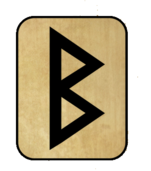 BERKANA (Beorc/Berkano) : birch Phonetic equivalent: B
BERKANA (Beorc/Berkano) : birch Phonetic equivalent: B
DIVINATORY MEANINGS:
Fertility, health, new beginnings, growth, conception, plenty, clearance
MAGICAL USES:
Healing (especially infections), achieving conception, making a fresh start
ASSOCIATED MYTHS & DEITIES:
Frigg Idunna
ANALYSIS:
The birch is fundamentally a symbol of fertility. There are numerous instances in European folk tradition where birch twigs are used to bring prosperity and encourage conception. They were fixed above a sweetheart's door on May Day in Cheshire, England, and were placed in stables and houses to promote fertility. On the continent, young men, women and cattle were struck with birch twigs for this same purpose, and young boys would be sent out to "beat the bounds of the parish" with branches of birch to ensure prosperity in the coming year. Witches were said to ride broomsticks made from birch, an image which probably originated with fertility rituals where dancers would 'ride' brooms through the fields, the height of their jumping indicating how high the grain should grow.
If teiwaz is the fundamental male mystery, then berkana certainly belongs to the women, for it represents the path of the mother, the healer and the midwife, bringing new life after death just as the birch puts out the first leaves after winter. While Tyr's wound is acquired through his encounter with death, berkana's wound is that of menstruation, and her ordeal is that of childbirth. The birch is abundant and all providing, and heals through nourishment, cleansing and empathy.
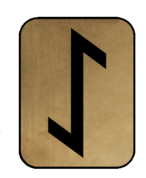 EHWAZ (Eoh) : horse Phonetic equivalent: E (as in 'egg')
EHWAZ (Eoh) : horse Phonetic equivalent: E (as in 'egg')
DIVINATORY MEANINGS:
Transportation, motion, assistance, energy, power, communication, will, recklessness
MAGICAL USES:
Power, aiding in communication, transportation; to 'send' a spell
ASSOCIATED MYTHS & DEITIES:
Sleipnir, Freya's feathered cloak
ANALYSIS:
The horse has been a powerful symbol in nearly every culture and every age. They were often believed to draw the sun about the heavens. Strong, swift and loyal, their relationship with humankind is unique. They allow us to perform tasks that would normally be beyond our strength, and to travel distances that would normally be beyond our reach. The mare symbolizes fertility and fecundity, and the stallion is the epitome of virility and raw energy. It is an animal that never lost its power by being domesticated.
Like the sun which is its counterpart, ehwaz represents energy and motion. In this case, however, there is also respect for the source of the power to be considered. This is not merely an impersonal energy source - it is a living, breathing thing whose needs and desires must be taken into consideration, rather than be simply used as a slave. This is the power that was given by the God at algiz, and this rune reminds us of our oath to only use it to help, never to harm. Like the two-edged sword, the horse is a powerful tool, but must be carefully controlled to avoid harming yourself or other. It is tempting to just go barreling along recklessly, but to do so is to risk loosing that power forever. This is the balance that must be achieved on the path of pure magic.
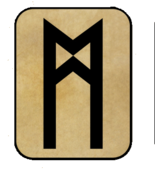 MANNAZ (Man/Mann) : man, humankind Phonetic equivalent: M
MANNAZ (Man/Mann) : man, humankind Phonetic equivalent: M
DIVINATORY MEANINGS:
Signification, self, family, community, relationships, social concerns
MAGICAL USES:
To represent a specific person or group of people; to establish social relationships
ASSOCIATED MYTHS & DEITIES:
Ask and Embla, Midgard
ANALYSIS:
In its broadest sense, mannaz represents all of humanity, and therefore the entire realm of Midgard. In more practical terms, though, it is those with whom we have personal connections, from our immediate circle of family and friends to the wider community around us, reminding us of our nature as social animals. It also represents our connection with the Gods and with nature, through the two Norse myths of the creation of humans; the first where they sprang from Ymir's body, and the second in which they were created from two logs by a river. It takes the raw energy of ehwaz and controls it through our social conscience, reminding us of those we affect with our deeds both magical and mundane.
The rune itself resembles gebo with its joining of masculine and feminine elements, but is much more complete. It is the entire web of human relationships, with the self at the centre, which mirrors the web of fate explored through raiðo. But while that web was more or less fixed, this one is mutable and alive. Past and present, male and female, self and other - all opposites are joined here and made whole. Mannaz is our home, and speaks for all those whose lives we touch when we use the gifts we have been given through the runes.
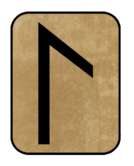 LAGUZ (Lagu/Logr/Laf): water Phonetic equivalent: L
LAGUZ (Lagu/Logr/Laf): water Phonetic equivalent: L
DIVINATORY MEANINGS:
Emotions, fears, unconscious mind, things hidden, revelation, intuition, counseling
MAGICAL USES:
Enhancing psychic abilities, confronting fears, stabilizing mental or emotional disorders, uncovering hidden things
ASSOCIATED MYTHS & DEITIES:
Njord, Midgard Serpent
ANALYSIS:
When most people think of water, they generally think of its more pleasant associations - peacefulness, love, compassion, intuition, and the emotions in general. However, we must remember that, to the Norse, water most often meant the sea, and the sea was a terrifying, unpredictable place, home of the Midgard serpent and the grave of many sailors. Laguz, then, should be thought of in terms of the lighter and the darker sides of the element of water. It speaks to our primal fears of the dark, the cold, and all those terrifying things hidden deep within our subconscious minds.
Like eihwaz, which forced the journeyer to confront his or her mortality, laguz makes us examine the underlying roots of our personality and behavior, and allows us to modify those aspects which are hindering our spiritual development. The understanding and wisdom gained through eihwaz and the runes which followed have prepared the journeyer to face this darker side (represented by laguz) and accept it as an integral part of their selves. Laguz also prepares the person to take on the task of helping others through this self-examination process, allowing them to empathize more strongly and share their own experiences, making it (among other things) the rune of the spiritual counselor.
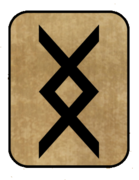 INGUZ (Ing/Ingwaz): Ing Phonetic equivalent: NG
INGUZ (Ing/Ingwaz): Ing Phonetic equivalent: NG
DIVINATORY MEANINGS:
Work, productivity, bounty, groundedness, balance, connection with the land
MAGICAL USES:
Fertility, farming, growth, general health, balance
ASSOCIATED MYTHS & DEITIES:
Freyr / Ing, Nerthus, Thor, the Vanir
ANALYSIS:
Ing is a Danish / Anglo-Saxon name for Freyr, the God of agriculture and fertility. Agriculture represents one of the first attempts by mankind to control the environment, and the fertility of crops, animals and people has always been the primary concern and religious focus of most Pagan agrarian societies. From the earliest Sumerian accounts to modern-day British folk custom, people throughout history have sought to ensure the success of their crops.
The vast majority of people in Western society have lost all contact and connection with the land and the process of growing things. The spiritual consequences of this segregation from the earth have been disastrous, since most people find it difficult to relate to deity in a purely man-made environment. The shape of this rune can be likened to that of a field, but its real significance may lie in its balance, representing the harmonious relationship between ourselves and the four elements / four directions. Ingwaz reminds us of that ancient connection between the Gods and the land, and re-links (the real meaning of the word 'religion') us with our spiritual natures through the realm of the physical. It is quite literally a grounding rune, and by reintroducing us to the earth, it reconnects our bodies, our minds and our spirits.
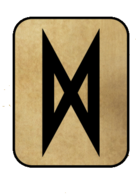 DAGAZ (Dag/Daeg) : day Phonetic equivalent: D (pronounced as 'th', as in 'this')
DAGAZ (Dag/Daeg) : day Phonetic equivalent: D (pronounced as 'th', as in 'this')
DIVINATORY MEANINGS:
Happiness, success, activity, a fulfilling lifestyle, satisfaction
MAGICAL USES:
To bring a positive outcome
ASSOCIATED MYTHS & DEITIES:
Sunna, Baldr, Nerthus, Yggdrasil
ANALYSIS:
This rune effectively marks the end of the third aett, leaving only oþila to complete the cycle. As in the previous two aetts, dagaz concludes the third with light and hope. However, while wunjo represented earthly glories and the sun, heavenly power, the day brings these two realms together, bringing the more abstract light and power of sowulo 'down to earth' and applying it to our everyday lives.
The shape of the rune itself denotes this kind of interconnection. It is reminiscent of gebo, with its balance of masculine, feminine and the four elements, but dagaz makes further connections to the celestial and the realm of nature. Like inguz, it symbolizes harmony with one's environment. But again takes it a step further, implying a harmonious relationship with the spiritual environment as well. It is a bringing together of all six cardinal points - the four compass directions, the celestial realm above us where the Gods are thought to dwell; and that which is below - all the spirits of the earth and of nature. All of these things are balanced and integrated through dagaz and brought into our daily lives.
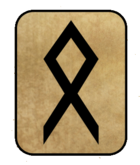 OTHALA (Odal/Othala/Ethel): property Phonetic equivalent: O
OTHALA (Odal/Othala/Ethel): property Phonetic equivalent: O
DIVINATORY MEANINGS:
Property, land, inheritance, home, permanence, legacy, synthesis, sense of belonging
MAGICAL USES:
For acquiring land or property, to complete a project, to strengthen family ties
ASSOCIATED MYTHS & DEITIES:
The nine worlds of Yggdrasil
ANALYSIS:
In othala, we find ourselves back in the seemingly mundane realm of wealth and property, just like the first rune, fehu. However, while cattle represented a more movable, transitory form of wealth, the land (as Mr. O'Hara said) is the only thing that lasts. It can be passed on as a legacy, but more importantly, it defines who we are by defining where we are. It is, ultimately, our home.
This rune brings us to the seventh cardinal point, which is the centre. It is the meeting place between Midgard and Asgard; between us and our Gods. It is the axis around which our lives revolve. The idea of land or property is only a symbol - we must all find our own "centre" (or, as Joseph Campbell termed it, our "bliss") to give our lives meaning, and this is really the ultimate goal of the runic journey. Like Dorothy in the Wizard of Oz, we discover that after all our travels and adventures; we all eventually end up going home. But this doesn't mean that the travels and adventures are pointless. On the contrary, it is only through those explorations that our 'home' or spiritual centre can have any real meaning for us. "There's no place like home" will have no power to send us there unless we come to truly understand what and where our home is to us. Conversely, none of the lessons learned along the way can be of any real use to us unless we actively integrate them into our 'mundane' lives and find that centre point to anchor them to. Othala not only completes the smaller cycle of the third aett, but also brings us back to the beginning of the fuþark itself, only on a higher level. We may now begin the grand cycle of the runic journey again.
Blank Rune
The blank rune (or 'Odin's Rune', or 'Wyrd') was invented by Ralph Blum, author of 'The Book of Runes'. Blum explains in the introduction to his book that he started out using a rune set someone gave him, not knowing the first thing about them, and sort of made things up as he went along from there. The blank rune was one of those things.
There is absolutely no evidence that a 25th 'blank' rune ever existed historically. Many subsequent books have been published based on Blum's, and so the fiction of the blank rune has been perpetuated.
The information on this site is adapted from
'Raido: The Runic Journey'
by Jennifer Smith, copyright 1994.
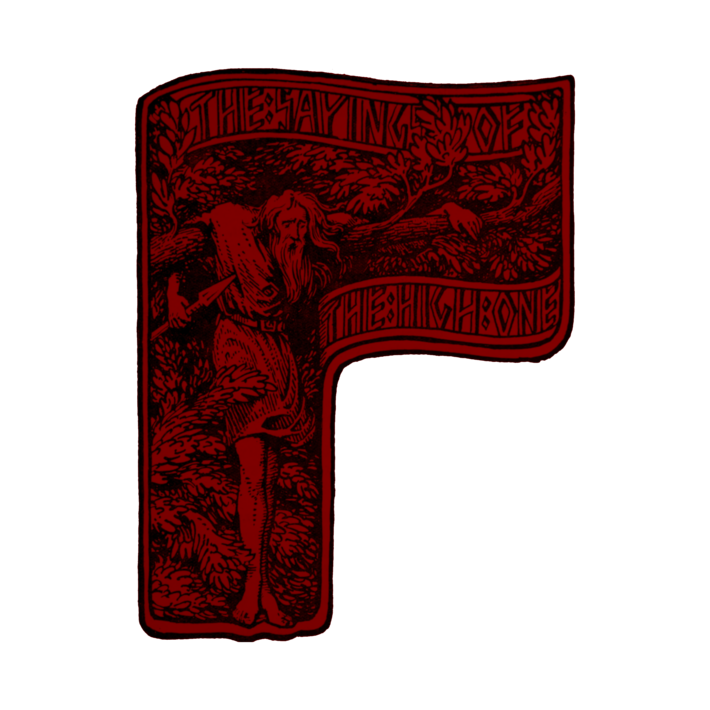
How Odin Obtained the Runes
Wounded I hung on a wind-swept gallows
For nine long nights,
Pierced by a spear, pledged to Odin,
Offered, myself to myself
The wisest know not from whence spring
The roots of that ancient rood.
They gave me no bread,
They gave me no mead,
I looked down;
With a loud cry
I took up runes;
From that tree I fell.
Nine lays of power
I learned from the famous Bolthor, Bestla' s father:
He poured me a draught of precious mead,
Mixed with magic Odrerir.
Waxed and throve well;
Word from word gave words to me,
Deed from deed gave deeds to me.
Runes you will find, and readable staves,
Very strong staves,
Very stout staves,
Staves that Bolthor stained,
Made by mighty powers,
Graven by the prophetic God.
For the Gods by Odin, for the Elves by Dain,
By Dvalin, too, for the Dwarves,
By Asvid for the hateful Giants,
And some I carved myself:
Thund, before man was made, scratched them,
Who rose first, fell thereafter.
Know how to cut them,
know how to read them,
Know how to stain them,
know how to prove them,
Know how to evoke them,
know how to score them,
Know how to send them,
know how to send them.
Better not to ask than to over-pledge
As a gift that demands a gift.
Better not to send
Than to slay too many.
The first charm I know is unknown to rulers
Or any of human kind;
Help it is named,
for help it can give
In hours of sorrow and anguish.
I know a second that the sons of men
Must learn who wish to be leeches.
I know a third: in the thick of battle,
If my need be great enough,
It will blunt the edges of enemy swords,
Their weapons will make no wounds.
I know a fourth:
it will free me quickly
If foes should bind me fast
With strong chains, a chant that makes
Fetters spring from the feet,
Bonds burst from the hands.
I know a fifth: no flying arrow,
Aimed to bring harm to men,
Flies too fast for my fingers to catch it
And hold it in mid-air.
I know a sixth:
It will save me if a man
Cut runes on a sapling' s roots
With intent to harm; it turns the spell;
The hater is harmed, not me.
If I see the hall
Ablaze around my bench mates,
Though hot the flames,
They shall feel nothing,
If I choose to chant the spell. [seventh]
I know an eighth:
That all are glad of,
Most useful to men:
If hate fester in the heart of a warrior,
It will soon calm and cure him.
I know a ninth:
When need I have
To shelter my ship on the flood,
The wind it calms, the waves it smoothes
And puts the sea to sleep
I know a tenth:
If troublesome ghosts
Ride the rafters aloft,
I can work it so they wander astray,
Unable to find their forms,
Unable to find their homes.
I know an eleventh:
When I lead to battle old comrades in-arms,
I have only to chant it behind my shield,
And unwounded they go to war,
Unwounded they come from war,
Unscathed wherever they are
I know a twelfth:
If a tree bear
A man hanged in a halter,
I can carve and stain strong runes
That will cause the corpse to speak,
Reply to whatever I ask.
I know a thirteenth
If I throw a cup of water over a warrior,
He shall not fall in the fiercest battle,
Nor sink beneath the sword,
I know a fourteenth, that few know:
If I tell a troop of warriors
About the high ones, Elves and Gods,
I can name them one by one.
(Few can the nitwit name.)
I know a fifteenth,
That first Thjodrerir
Sang before Delling's doors,
Giving power to Gods, prowess to Elves,
Fore-sight to Hroptatyr Odhinn,
I know a sixteenth:
If I see a girl
With whom it would please me to play,
I can turn her thoughts, can touch the heart
Of any white armed woman.
I know a seventeenth:
If I sing it,
The young girl will be slow to forsake me.
I know an eighteenth that I never tell
To maiden or wife of man,
A secret I hide from all
Except the love who lies in my arms,
Or else my own sister.
To learn to sing them, Loddfafnir,
Will take you a long time,
Though helpful they are if you understand them,
Useful if you use them,
Needful if you need them.
The Wise One has spoken words in the hall,
Needful for men to know,
Unneedful for trolls to know:
Hail to the speaker,
Hail to the knower,
Joy to him who has understood,
Delight to those who have listened.

The Rune Poems
Three ancient poems were created as mnemonic aids for remembering the rune symbols, their names, meanings and properties. Because the runes changed slightly in each culture the three poems differ in some aspects.
The Old Norse Rune Poem
From Runic and Heroic Poems by Bruce Dickins
Fe
Wealth is a source of discord among kinsmen;
the wolf lives in the forest.
Ur
Dross comes from bad iron;
the reindeer often races over the frozen snow.
Thurs
Giant causes anguish to women;
misfortune makes few men cheerful.
As
Estuary is the way of most journeys;
but a scabbard is of swords.
Reidh
Riding is said to be the worst thing for horses;
Reginn forged the finest sword.
Kaun
Ulcer is fatal to children;
death makes a corpse pale.
Hagall
Hail is the coldest of grain;
Christ created the world of old.
Naudhr
Constraint gives scant choice;
a naked man is chilled by the frost.
Isa
Ice we call the broad bridge;
the blind man must be led.
Ar
Plenty is a boon to men;
I say that Frodi was generous.
Sol
Sun is the light of the world;
I bow to the divine decree.
Tyr
Tyr is a one-handed god;
often has the smith to blow.
Bjarkan
Birch has the greenest leaves of any shrub;
Loki was fortunate in his deceit.
Madhr
Man is an augmentation of the dust;
great is the claw of the hawk.
Logr
A waterfall is a River which falls from a mountain-side;
but ornaments are of gold.
Yr
Yew is the greenest of trees in winter;
it is wont to crackle when it burns.

The Icelandic Rune Poem
(in Modern English)
From Runic and Heroic Poems by Bruce Dickins
Fe - Wealth
Source of discord among kinsmen
and fire of the sea
and path of the serpent.
Ur - Shower
Lamentation of the clouds
and ruin of the hay-harvest
and abomination of the shepherd.
Thurs - Giant
Torture of women
and cliff-dweller
and husband of a giantess.
Oss - God
Aged Gautr
and prince of Ásgardr
and lord of Vallhalla.
Reid - Riding
Joy of the horsemen
and speedy journey
and toil of the steed.
Kaun - Ulcer
Disease fatal to children
and painful spot
and abode of mortification.
Hagall - Hail
Cold grain
and shower of sleet
and sickness of serpents.
Naud - Constraint
Grief of the bond-maid
and state of oppression
and toilsome work.
Isa - Ice
Bark of rivers
and roof of the wave
and destruction of the doomed.
Ar - Plenty
Boon to men
and good summer
and thriving crops.
Sol - Sun
Shield of the clouds
and shining ray
and destroyer of ice.
Tyr
God with one hand
and leavings of the wolf
and prince of temples.
Bjarken - Birch
Leafy twig
and little tree
and fresh young shrub.
Madr - Man
Delight of man
and augmentation of the earth
and adorner of ships.
Logr - Water
Eddying stream
and broad geysir
and land of the fish.
Yr - Yew
Bent bow
and brittle iron
and giant of the arrow.

The Anglo-Saxon Rune Poem
(in Modern English)
From : Runic and Heroic Poems, by Bruce Dickins.
Feoh
Wealth is a comfort to all men;
yet must every man bestow it freely,
if he wish to gain honour in the sight of the Lord.
Ur
The aurochs is proud and has great horns;
it is a very savage beast and fights with its horns;
a great ranger of the moors, it is a creature of mettle.
Thorn
The thorn is exceedingly sharp,
an evil thing for any knight to touch,
uncommonly severe on all who sit among them.
Os
The mouth is the source of all language,
a pillar of wisdom and a comfort to wise men,
a blessing and a joy to every knight.
Rad
Riding seems easy to every warrior while he is indoors
and very courageous to him who traverses the high-roads
on the back of a stout horse.
Cen
The torch is known to every living man by its pale, bright flame;
it always burns where princes sit within.
Gyfu
Generosity brings credit and honour, which support one's dignity;
it furnishes help and subsistence
to all broken men who are devoid of aught else.
Wynn
Bliss he enjoys who knows not suffering, sorrow nor anxiety,
and has prosperity and happiness and a good enough house.
Haegel
Hail is the whitest of grain;
it is whirled from the vault of heaven
and is tossed about by gusts of wind
and then it melts into water.
Nyd
Trouble is oppressive to the heart;
yet often it proves a source of help and salvation
to the children of men, to everyone who heeds it betimes.
Is
Ice is very cold and immeasurably slippery;
it glistens as clear as glass and most like to gems;
it is a floor wrought by the frost, fair to look upon.
Ger
Summer is a joy to men, when God, the holy King of Heaven,
suffers the earth to bring forth shining fruits
for rich and poor alike.
Eoh
The yew is a tree with rough bark,
hard and fast in the earth, supported by its roots,
a guardian of flame and a joy upon an estate.
Peordh
Peorth is a source of recreation and amusement to the great,
where warriors sit blithely together in the banqueting-hall.
Eolh
The Eolh-sedge is mostly to be found in a marsh;
it grows in the water and makes a ghastly wound,
covering with blood every warrior who touches it.
Sigel
The sun is ever a joy in the hopes of seafarers
when they journey away over the fishes' bath,
until the courser of the deep bears them to land.
Tir
Tiw is a guiding star; well does it keep faith with princes;
it is ever on its course over the mists of night and never fails.
Berok
The poplar bears no fruit; yet without seed it brings forth suckers,
for it is generated from its leaves.
Splendid are its branches and gloriously adorned
its lofty crown which reaches to the skies.
Eh
The horse is a joy to princes in the presence of warriors.
A steed in the pride of its hoofs,
when rich men on horseback bandy words about it;
and it is ever a source of comfort to the restless.
Mann
The joyous man is dear to his kinsmen;
yet every man is doomed to fail his fellow,
since the Lord by his decree will commit the vile carrion to the earth.
Lagu
The ocean seems interminable to men,
if they venture on the rolling bark
and the waves of the sea terrify them
and the courser of the deep heed not its bridle.
Ing
Ing was first seen by men among the East-Danes,
till, followed by his chariot,
he departed eastwards over the waves.
So the Heardingas named the hero.
Ethel
An estate is very dear to every man,
if he can enjoy there in his house
whatever is right and proper in constant prosperity.
Daeg
Day, the glorious light of the Creator, is sent by the Lord;
it is beloved of men, a source of hope and happiness to rich and poor,
and of service to all.
Ac
The oak fattens the flesh of pigs for the children of men.
Often it traverses the gannet's bath,
and the ocean proves whether the oak keeps faith
in honourable fashion.
Aesc
The ash is exceedingly high and precious to men.
With its sturdy trunk it offers a stubborn resistance,
though attacked by many a man.
Yr
Yr is a source of joy and honour to every prince and knight;
it looks well on a horse and is a reliable equipment for a journey.
Ior
Iar is a river fish and yet it always feeds on land;
it has a fair abode encompassed by water, where it lives in happiness.
Ear
The grave is horrible to every knight,
when the corpse quickly begins to cool
and is laid in the bosom of the dark earth.
Prosperity declines, happiness passes away
and covenants are broken.

The Old Swiss Rune Poem
There is yet another rune poem, the Abcedarium Nordmanicum, discovered in a manuscript written in the 9th century, written in high and low German. This is sometimes referred to as the "Old Swiss Rune Poem". It relates to the Younger Futhark.
Fee first,
Aurochs after,
Thurs the third stave,
The Åse is above him,
Wheel is written last,
Then cleaves cancre;
Hail has need;
Ice, year, and sun.
Tiu, birch and man in the middle;
Water the bright,
Yew holds all.
8840474




